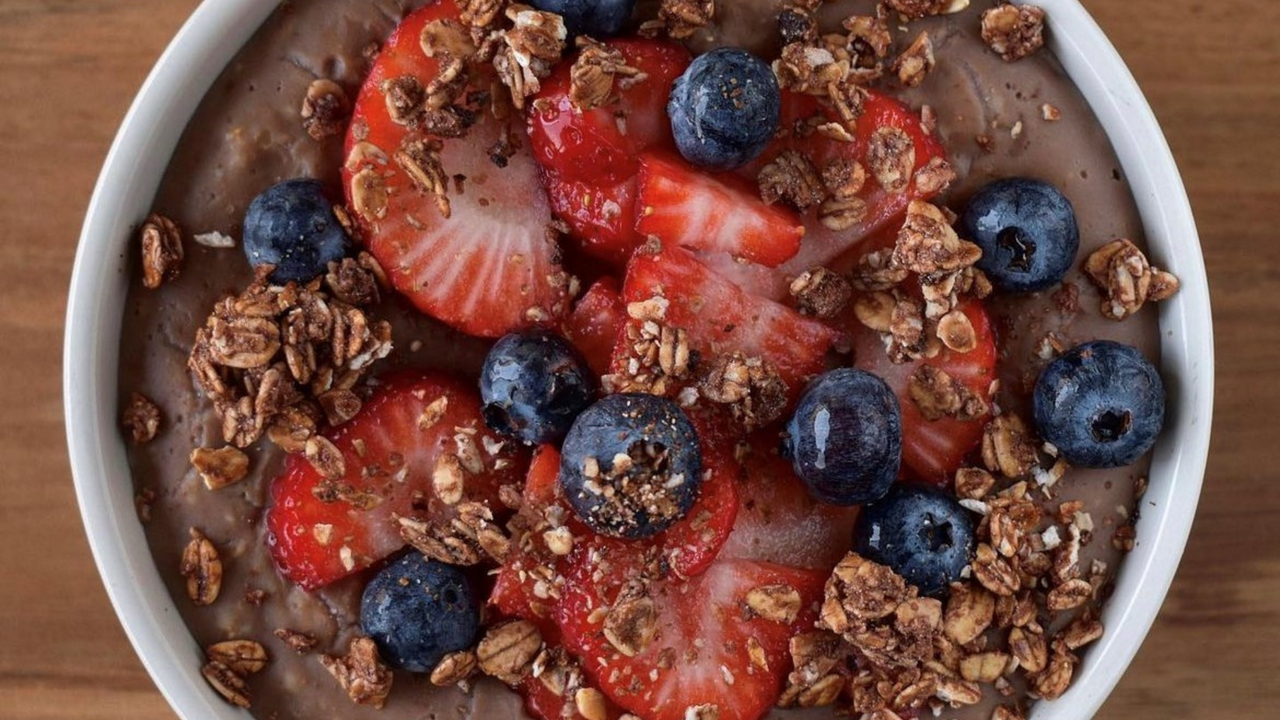
Surprising Benefits of Gluten-Free Granola

Introduction
If you are looking for a delicious and nutritious gluten-free snack, this, gluten-free granola can definitely be your best friend. Not only does it satisfy your cravings, but its loaded with gut healthy superfoods that will keep you full the whole day!
Let's find out more about gluten-free granola and its health benefits, and remember read until the end where we'll also be sharing two delicious gluten-free recipes..
What is gluten?
Before we talk about gluten-free granola, let us first understand what gluten is, its role in our body, and its common sources. Let us also learn what it means to be gluten-intolerant.
Definition and role of gluten in our body

Image source: Pexels
Gluten is a family of natural proteins found in some grains like barley, wheat, and rye. It acts as a binding agent that holds food together and generally speaking gives food like pizza dough, pasta, donuts etc, its elasticity. Without gluten, these foods would easily break apart.
Common sources of gluten in our diet

Image source: Pexels
Since gluten is a protein found in wheat, barley, rye, and other grains, you can find it in many foods we commonly consume. Here are some familiar sources of gluten:
- Baked goods: Breads, pastries, cakes, cookies, muffins, and other baked goods are made with wheat flour.
- Pasta: Most traditional pasta is made with wheat flour, but gluten-free options are also available.
- Cereal and grains: Wheat, barley, and rye are often used in breakfast cereals, granolas, and porridges, as well as in other grains like bulgur and couscous.
- Beer: Most beers are made with barley, which contains gluten. However, gluten-free beer is also available.
- Processed and packaged foods: Many processed and packaged foods, including soups, sauces, and dressings, may contain gluten as a thickener or filler.
- Snack foods: Pretzels, crackers, and other snack foods are often made with wheat flour.
- Seitan: This vegetarian meat protein substitute is made from wheat gluten.
What is gluten intolerance?

Image source: Pixabay
Gluten intolerance is a broad term used to describe a range of conditions in which an individual experiences adverse reactions after consuming foods containing gluten.
When we eat gluten, the digestive enzymes in our bodies process them. However, they cannot fully break them down. The unprocessed gluten then makes its way to the small intestines. While many people can take the excess gluten, some of us are gluten intolerant, experiencing distressing symptoms and reactions. The reason so many people have become intolerant to gluten is a bit complex. Many things have contributed such as; the way our crops have been genetically modified and altered to become more drought resistant, modification for increased crop yields, the general population becoming increasingly vitamin deficient just to name a few.
Gluten intolerance can include celiac disease, non-celiac gluten sensitivity, and wheat allergy, which all have distinct mechanisms and symptoms.
Celiac disease
This autoimmune disorder happens when the immune system mistakenly attacks the small intestine after consuming gluten. Celiac disease can cause damage to the lining of the small intestine, leading to a range of symptoms, including diarrhea, abdominal pain, bloating, weight loss, and malnutrition.
Non-celiac gluten sensitivity
The non-celiac gluten sensitivity is a condition in which one might experience similar symptoms to celiac disease after consuming gluten but without the autoimmune response or intestinal damage. Symptoms of non-celiac gluten sensitivity can include diarrhea, abdominal pain, bloating, and fatigue.
Wheat allergy
This allergy is an immune-mediated reaction to one or more proteins found in wheat. Symptoms can range from mild, such as hives and itching, to severe, such as anaphylaxis.
Why some people choose a gluten-free diet

Some people also choose to follow a gluten-free diet for various reasons, including the following:
To address digestive issues
People with certain digestive issues, such as celiac disease, non-celiac gluten sensitivity, or irritable bowel syndrome (IBS), may choose a gluten-free diet to alleviate their symptoms. However, it's important to note that not all digestive issues are related to gluten, and a gluten-free diet may not be effective for everyone. If you suspect a gluten-related digestive issue, talk to your doctor or a registered dietitian to determine if a gluten-free diet is necessary for your health.
To try a new diet that may improve health and increase energy
While more research needs to be done, some people may choose a gluten-free diet for perceived health benefits and increased energy. Some individuals have reported having more energy and feeling better after adopting a gluten-free diet. However, this could be due to other factors, such as increased fruit and vegetable intake, decreased consumption of processed foods, or improved gut health.
To manage other health conditions
Some people may choose a gluten-free diet to manage other health conditions.
For example, some studies have suggested that a gluten-free diet may benefit people with rheumatoid arthritis, multiple sclerosis, or type 1 diabetes. In some cases, a gluten-free diet may be recommended as part of a broader treatment plan for these conditions. Still, it's important to talk to your doctor or a registered dietitian before making any significant changes to your diet.
Additionally, some people may choose a gluten-free diet as part of a general health regimen. They believe it can help reduce inflammation, boost the immune system, or improve overall well-being. However, more studies are needed to support these claims.
Gluten-free granola as a healthier alternative

In case of gluten sensitivity, observing a gluten-free diet can be a beneficial choice. And if you are on this diet, you may have limited food choices. It may be hard to find breakfast and snack items that are not only gluten-free but also healthy and enjoyable to consume. This is when gluten-free granola becomes a healthier alternative.
With the right ingredients, gluten-free granola will give you the energy and nutrients you need to get you through the day without debilitating adverse reactions. It is also delicious, easy to prepare, and offers various health benefits.
Benefits of gluten-free granola

The benefits of gluten-free granola depend on the specific ingredients used to make it and the overall quality of the product. However, some potential benefits of gluten-free granola include the following:
May support digestion
If you have celiac disease or gluten sensitivity, avoiding gluten-containing foods like regular granola can help alleviate digestive symptoms. Gluten-free granola made with whole grains, nuts, seeds, and fruits can also give you fiber, which supports digestion and helps promote regular bowel movements.
May help with weight management
The ingredients of gluten-free granola can make a satisfying and filling breakfast or snack option. Its fiber and protein content can help control appetite and prevent overeating, which may support weight management goals.
Provides essential nutrients
Gluten-free granola can be a good source of important nutrients like vitamins, minerals, and antioxidants. Depending on the ingredients, it can provide essential nutrients like iron, magnesium, and vitamin E.
Can be a convenient and tasty breakfast or snack
Gluten-free granola can be a convenient and delicious breakfast that you can personalize according to your liking. You can check out our various recipes to create delicious granola bowls, bars, smoothies, and more.
How to choose gluten-free granola
Choosing gluten-free granola can be a challenge. You have to pay attention to the labels and ingredients to ensure you get high-quality and healthy gluten-free granola. Check the label and see to it that it specifically states that the product is gluten-free. Some brands will also have a certified gluten-free symbol on the packaging, indicating that they meet all the standards to be considered free of this substance.
Additionally, look at the ingredients list and ensure none contain wheat, barley, or rye derivatives like malt extract or hydrolyzed wheat protein.
Check out Avinola Superfood Granola, a keto-friendly granola that contains lupini (LINK TO LUPINI BEANS ARTICLE) flakes known to give various health benefits.
Recipes for gluten-free Avinola
Avinola is a gluten-free superfood granola made with superfood ingredients, such as lupini beans, chia seeds, flax seeds, pecans, almonds, coconut flakes, coconut oil, and Monkfruit extract.
Here are some easy and tasty gluten-free Avinola recipes you can try:
Dark Mocha Smoothie

If you want an interesting drink to start your day, this recipe is for you. This smoothie will surely give you energy and keep you alert.
Ingredients:
- 1 frozen banana (cut into chunks)
- 1 T chia seeds
- 1 T cocoa powder
- 1 T cacao nibs
- 1 Medjool date
- 1/4 cup coffee (cooled)
- Gluten-free milk of choice
- Double chocolate sea salt Avinola
Directions:
- Blend all the ingredients together except for the Avinola, adding milk as needed to get to your desired consistency.
- Add Avinola to the bottom of a glass.
- Pour the smoothie on top.
- Top with more Double Chocolate Sea Salt Avinola and enjoy!
4-Ingredient Keto Bark

This delicious treat is both gluten-free and keto-friendly, perfect for breakfast or snacks.
Ingredients:
- Yogurt of choice
- Avinola (sweet almond coconut is used here!)
- Fruit of choice
- Honey to drizzle on top (you can also use melted chocolate, maple syrup, agave, etc.!)
- Any other toppings you like! Think coconut flakes, chocolate chips, nuts, dried fruit, etc.
Directions:
- Line your baking dish or plate with parchment paper.
- Spread some yogurt in an even layer about 1/4 inch thick.
- Add your Avinola and other toppings.
- Freeze for about 2 hours or until set.
- Break into pieces, and enjoy!
Be sure to store any leftovers in the freezer to enjoy later.
Conclusion
While eating a gluten-free diet can be tricky, with the right ingredients, it doesn't have to be. Gluten-free granola, just like Avinola, is the perfect choice for those on a gluten-free diet. It offers all the benefits of regular granola without the risk of triggering any adverse reactions. Best of all, they are delicious, versatile, and easy to prepare. Check out the variety of simple recipes and see which one becomes your favorite!

